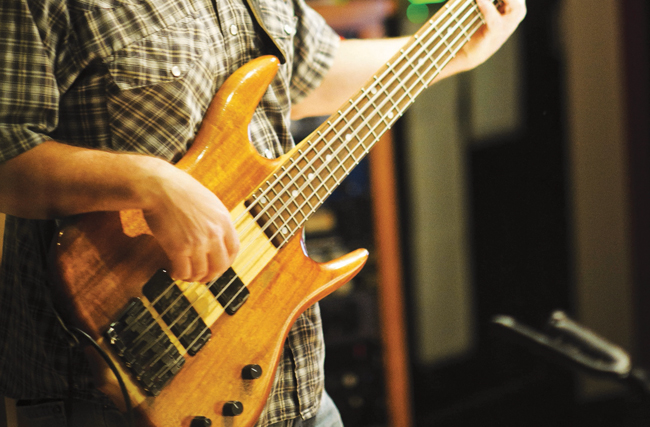How to Get That Low End to Sing
When we were kids, we didn’t have bass amp simulator plug-ins – we had bass amps and expensive microphones and we liked it! Today we are fortunate to have better options to record bass guitar.
One thing we should point out right away when it comes to recording bass in the studio is that we usually record bass at the same time as the other rhythm instruments (drums, guitars and keys) to capture the energy of live performance. This presents a challenge because bass players, as we know, usually like to let loose at very loud levels. In our studio, we often have the bass player perform in the same iso room with the drummer. They are still wearing headphones with individual monitor mixes but we have found that being in the same space “magically” brings out tighter performances.
DI, Close Miking & Plug-ins
A common technique for recording bass in the past was to split the signal, recording both a direct out and close miking the bass amp. This technique used to be the only way to have more options later in the mix between the dry and amped sound. This technique has its drawbacks if the bass player and drummer share the same room because miking the bass amp would cause two leakage problems: 1) bass leaking into the drum mics and 2) drums leaking into the bass mic. Luckily things have changed for the better.
With the invention of amp simulator plug-ins, we now have the best of both worlds. We often record the bass directly and feed it back into the bands’ headphones during tracking. For some bassists, this form of monitoring takes some getting used to because they are used to “feeling” booming vibrations when they play. But usually after a few minutes of warm up and some mix adjustment, they are good to go (and the rest of the band often appreciates that they can now control just how much bass they are getting in their headphone mix).
Direct Recording Impedance
If we do record the bass direct, there are some things to keep in mind and we have to get into a quick “nano” discussion about impedance. Instruments like bass guitars are high impedance (Hi-Z) and many older recording mixers and interfaces only have low impedance (Lo-Z) inputs. In this case, we need to use a direct box to change the impedance if we are recording directly from the bass guitar or from the pedal board.
Because direct boxes are designed for many situations, we like to use ones designed specifically for bass guitars, like SansAmp Bass Driver DI by Tech21. Nowadays things have changed and most recording gear has both Lo-Z and Hi-Z, so you can just plug into the appropriate input. We like when bassists come into the studio with bass heads that have pre-amp outputs (like the GK MB line or Ampeg SVT series) so that we can just plug in an XLR cable direct to the board and we’re good to go. This saves the hassle of lugging a heavy bass cabinet into the studio and we still capture the bass player’s unique sound.
EQ and Compression
We usually record the bass with no EQ on the board and just a bit of compression limiting so that a performance that gets louder than expected will not be ruined by digital distortion. Once we have recorded the performance using this direct technique, we have a completely isolated bass track with no leakage from other instruments. At this point, if the band is happy with the recorded rhythm track, we will dim-solo (bring up the volume in the mix of the selected track) the bass track and listen for any bass flubs that need to be overdubbed. It is best to do this now before any settings get changed on the pedal board or amp. Once everyone is happy with the bass performance, we often use amp simulators (like Guitar Rig 4 by Native Instruments or Amplitube by IK Multimedia), compressors and EQ plug-ins to change the overall bass sound. It is important to mention that it is easier to give the bass more character (growl, warmth, punch) than it is to remove it after tracking – so if possible have the bass player back off a bit on a real nasty or distinct sounds unless you are sure you will want it in the final mix.
Mic Selection and Placement
When we do decide to mic the bass amp, there are a couple of things to consider: mic selection and placement. There are no “right” answers to either. We often close mic the cabinet with mics like the AKG D112 and Sennheiser MD421, which work great. But the best way is to do a little experimenting. If we have the luxury of time, we like to have the bassist start playing to the track and have an assistant move the mic to different locations on the speaker cone and different distances from the cabinet for about 10 seconds at a time, while we take notes on each location. Then we’ll play back the track with the rest of the mix and see which location gave us the sound we wanted. If nothing quite works, then we change the mic and do it again until everyone’s happy (or we get a new bass player, just kidding).
Zac Cataldo is a musician and owner/producer at Night Train Studios, a recording studio in Westford, MA. He is also co-owner of Black Cloud Productions, a music publishing company. Contact him at [email protected].
Brent Godin is a bassist/guitarist and engineer/producer at Night Train Studios and talent scout at Black Cloud Productions. Contact him at [email protected].
Find them at nighttrainstudios.com and blackcloudproductions.com.
Photo by Johnny Arguedas
